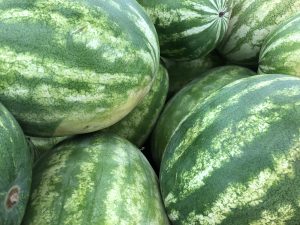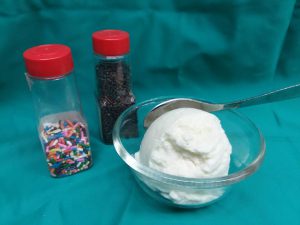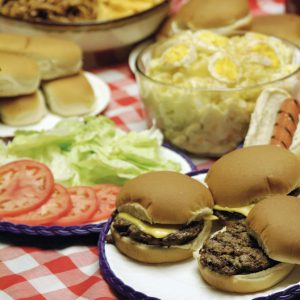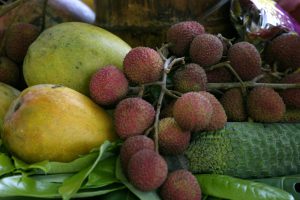
by Dorothy C. Lee | Jul 21, 2019
Eating healthy is not something that just happens by going on a particular diet. In fact, the best kind of diet is where the right choices are made, and it becomes a way of life. Sometimes we need to know some ways to change the bad habits we have developed. There is no ‘quick fix’.

Tune Up Your Lifestyle
Photo Source: UF/IFAS
With today’s fast-paced lifestyles sometimes we feel we don’t have the time to do the things we know we should. For instance, to get more exercise, do things like park a distance from the store when you go shopping, walk up and down the stairs instead of taking the elevator, walk to lunch, or even turn up the speed on regular activities you perform around the house.
When grocery shopping choose foods from the basic food groups (fruits, vegetables, whole grains, lean protein, and reduced-fat dairy products) to round out a healthy meal plan.
Convenience foods are a part of today’s lifestyle, but they often lack nutritional quality, texture, and flavor. Preparing foods at home can be healthy and economical. You can boost nutrition and flavor by adding fresh herbs, spices, and aromatic vegetables to the meal menu.
Foods and beverages high in sugar add empty calories to the diet and contribute no nutritional value. Read labels to determine the amount of added sugar in food products. Choose lower calorie beverages.
Experiment with new food items. Try adding different fruits, vegetables, or grains to your diet. For example, try tropical fruits such as mango, guava, papaya, or grains as quinoa, barley, or millet, to add vitamins, minerals and fiber to the diet.
Before you go out to eat, don’t starve yourself. Drink water before the meal to avoid overeating or eat a snack before dinner and you won’t be tempted to overeat.
When socializing don’t meet at eating places. When you do dine out, cut out fried main dishes or ones with heavy sauces and gravies. Eat smaller portions and don’t go back for seconds. Order low-fat foods when possible. However, keep in mind that you too need to allow for indulgence along the way.
Be active! Physical activity has health benefits. Being physically active not only burns calories, it aids in physical strength, and cardiovascular health. U.S. Dietary Guidelines recommend being physically active at least 150 minutes a week for adults. (https://health.gov/dietaryguidelines/).
Chances are, along with a healthy diet and regular physical activity, your tune up will result in living a healthy lifestyle.
https://www.freshfromflorida.com/Consumer-Resources/Buy-Fresh-From-Florida/Tropical-Fruit
https://www.tropicalfruitgrowers.com/
For further information, contact:
Dorothy C. Lee, C.F.C.S.
UF/IFAS Extension Escambia County
3740 Stefani Road
Cantonment, FL 32533-7792
(850) 475-5230
dclee@ufl.edu

by jbreslawski | Jul 18, 2019

Photo source: UF/IFAS Northwest District
Have you noticed recently that there have been many sales on watermelon at your local grocery store and farmers’ markets and roadside stands have an abundant supply? That is because watermelon and July go together like peanut butter and jelly or bacon and eggs. This cool and refreshing fruit is now in season locally. Whether you like to spit seeds or prefer the seedless variety, this fruit is a healthy addition to your plate. Naturally low in sodium and calories, watermelon is an excellent source of vitamin A and can help keep you hydrated. It also is an excellent source of the antioxidant, lycopene (which gives the melon meat that pretty reddish-pink color). To select the best watermelon, look for one that is heavy for its size, has a uniform shape, and a dark, dull green color. A yellow spot on one side means that the fruit has been given time to ripen in the field and develop flavor.
Do not forget to give your watermelon a good rinse under cool water before slicing. Putting a knife through that melon can carry all of the bacteria from the rind and spread it onto the fruit. Since watermelon is not usually cooked, that means that bacteria will not be killed and you have a chance of getting a foodborne illness. Remember to do this with your cantaloupe and other melons too. Too much watermelon? Try serving watermelon in different ways like in a melon salad, or even in, or alongside, chicken salad. Watermelon should be refrigerated after being cut and can be frozen too. Use chunks of frozen watermelon in smoothies and other drinks too.
Here is a recipe for a bubbly, refreshing watermelon drink from Fresh From Florida to serve at your July picnic:
FLORIDA WATERMELON FIZZ
INGREDIENTS: 5 cups Florida watermelon (seeded and cubed); Florida honey, to taste; 2 cups sparkling water; one lemon, juiced; Fresh mint sprigs for garnish
PREPARATION: Add watermelon, honey, and lemon juice to a blender and process until smooth. Strain puree through a fine sieve or strainer. Fill four glasses with ice. Evenly distribute the strained juice into each glass. Top each glass with sparkling water and stir once. Garnish with fresh mint sprigs.
https://www.followfreshfromflorida.com/recipes/florida-watermelon-fizz/#

by Angela Hinkle | Jul 18, 2019
Cold and refreshing on a hot summer day. Official by presidential proclamation. It practically saved my life once. Behold – The Power of Ice Cream.
HISTORY
Some say the Chinese invented ice cream in the first century. Roman emperors are also credited with flavoring ice gathered from mountain tops. Still others say ice cream found its start in the areas of Iran or Ancient Greece. Regardless of its origins, ice cream was often only available to royalty who could afford the resources to make it. Once refrigeration/freezing became affordable, the popularity and availability of ice cream rose considerably. So now, most of us – royalty or not – can enjoy the Power of Ice Cream all year long.
THE 411
- Ice Cream is made with greater than 10% milkfat.
- Gelato is generally made up of 7%-8% fat.
- Soft serve has more air mixed in.
- Frozen Yogurt is usually lower in fat and is often available soft-serve style.
- Sherbet freezes a combination of fruit juice with milk, cream, egg white, or gelatin.
THE 911
Picture it. Moving day. One of the hottest, most humid days of the year. The kind of day that you feel like you’re walking around in really warm soup. Though I’m staying hydrated, after about four hours in, it hits me. I go into a fog and literally start to go down to the ground. Luckily, my dad is pretty quick on his feet for a big Sicilian man. He puts me in the shade and says, “Don’t move!’ To this day, I don’t know how he did it so fast, but within two minutes, he got me the best cold ice cream dessert ever. The world was quickly righted as was I. Though this is NOT normal emergency protocol, it’s my miracle ice cream story and I’m sticking to it.
COOL TIDBITS

A cool and refreshing sweet treat
Photo Source: Angela Hinkle
- The United States leads the way in ice cream consumption, eating or licking or drinking about 48 pints or 23 pounds a year.
- President Ronald Reagan declared July National Ice Cream Month. The third Sunday in July, this year July 21st, is National Ice Cream Day.
- Though boasting 31 flavors, Baskin Robbins’ most popular flavor is vanilla.
- Because acquiring vanilla was so difficult before the mid-1800s, vanilla ice cream was considered quite an exotic treat.
- Sometimes, because nerve endings on the roof of your mouth suddenly get cold from eating ice cream, your brain tells the blood vessels, “Contract!” When they go back to their normal size, blood rushes back in. And ooh, “ice cream headache.” One recommendation to prevent this “brain freeze” is to eat slowly. And a recommendation to stop it is to put your tongue up to the roof of your mouth. Nothing guaranteed – so good luck.
- 15%-20% of Americans say they eat ice cream in bed. For more interesting ice cream trivia, visit foodreference.com
BENEFITS
Though not a particularly nutrient dense food, ice cream does have some health benefits. The area of your brain called the orbitofrontal cortex – or pleasure center – is activated when people are happy. Eating ice cream has been identified with having an immediate “happy” effect on the brain. There is also calcium in ice cream, which is good for building strong bones and teeth. Question – should all your daily calcium come from ice cream? Answer – Um, No. Try to choose more calcium-rich foods that are lower in fat and sugar.
So, in moderation of course, enjoy the Power of Ice Cream!

Cold, Delicious, and so many flavors! Photo source: Lyndsey B.
See Below for two healthier ice cream options. Yum!
MyPlate Sundae
This recipe includes all five food groups.
Layer in a clear glass bowl, mug, or cup so you can see all the colorful layers.
- Dairy – Gelato or frozen yogurt – your choice of flavor
- Vegetable – Frozen sweetened rhubarb or cooked, mashed, and cooled sweet potato
- Fruit – Most any berry works great
- Grain – granola
- Protein – Sprinkle on your favorite nuts
Cool and Creamy Calcium Dreamy
Serves 3
Items needed
1 – gallon heavy-duty ziptop bag
1 – quart heavy-duty ziptop bag
rock salt
ice
Procedure – In the 1 quart bag add the following:
¼ cup pasteurized liquid eggs
1 cup fat-free milk
1 cup fat-free half and half
½ cup sugar
1 teaspoon vanilla flavoring
Zip the top closed. Put the 1-quart bag inside the gallon bag. Pack the gallon bag with ice and ¾ cup of rock salt. Close the top. Work the bag back and forth – rolling over and over or tossing back and forth for 15 minutes. It may help to have potholders or a dish towel to hold the bag, as it will get very cold. Drain the water off and stir your cool and creamy calcium dreamy. Repack the gallon bag with ice and rock salt and roll or toss for five more minutes.
Serve immediately with fresh local fruits and nuts. Enjoy!
For more about the dairy food group see https://www.choosemyplate.gov/dairy

by Samantha Kennedy | Jul 2, 2019

Picnics are a great way to share food and fun with friends and family. By following a few simple food safety tips, you can make sure foodborne illness doesn’t crash your party. (Photo source: UF/IFAS file photo)
There are few things more iconic during summer than a picnic. There’s just something fresh and fun about sharing a meal in the park or at the beach with family and friends. But just because you’re enjoying the warm, gentle breeze doesn’t mean you should throw caution to the wind. By following a few simple food safety tips, you can ensure that your perfectly planned picnic doesn’t make you sick.
Plan appropriately. Not all foods are picnic-appropriate. Anything that requires a lot of perishable ingredients and/or a lot of preparation should be avoided. Stick with foods that require little or no cooking and that contain just a few ingredients. Foods such as fruits and vegetables (especially whole ones), hard cheeses, peanut butter and jelly, cereal, bread, and crackers are ideal picnic items. Anything made with commercially processed custard or mayonnaise will stay safe as long as it is kept cold.
Pack it safely. Use a cooler, if possible, and store cold foods together so they can help each other stay colder longer. Use ice or frozen gel packs to help keep foods cold. Pack foods directly from the refrigerator into the cooler; don’t leave them sitting out before packing. Store ready-to-eat foods separately from raw meats. If packing up hot foods, be sure to keep them in a thermos or other insulated dish. DO NOT store them in the same container as the cold foods. Paper towels, disposable utensils, and a food thermometer are ideal picnic accessories. Remember, keep cold foods below 41 degrees F and hot foods above 135 degrees F. Do your best to keep the cooler away from direct sunlight by storing it in the shade and be sure to replenish the ice and/or frozen gel packs when they melt. If possible, store drinks in a separate cooler so cold foods are not exposed to warm air with frequent openings of the lid to retrieve drinks. This also reduces the risk of cross-contamination, with fewer hands reaching into the food cooler.
Prepare it carefully. All food items should be kept at the proper temperature at all times. When cooking raw meats, use separate plates for the raw and cooked products and clean and sanitize utensils between uses. Cook meat to the proper recommended internal temperature to ensure doneness and safety. Click here for a list of recommended internal cooking temperatures.
Clean up quickly. Discard any perishable foods that have been left out for longer than two hours. In really hot weather (generally above 90 degrees F), foods should not be left out longer than one hour. Keep food protected in storage containers such as coolers and lidded dishes to minimize contamination from flies and other pests. Serve small portions of food at a time and keep the rest in the cooler.
Picnics are an important part of summer and with just a little bit of planning and a few useful tips and tools, they can be safe and delicious for everyone!
Related links:
Food Safety at Tailgating (University of Florida/IFAS)
Picnic Safety (Iowa State University)
Checklist for the Perfect Summer Picnic (foodsafety.gov)
Extension classes are open to everyone regardless of race, creed, color, religion, age, disability, sex, sexual orientation, marital status, national origin, political opinions or affiliations.

by Heidi Copeland | Jun 20, 2019
Part of cultivating a healthy, sustainable food system is to learning eat seasonally and locally. This means enjoying foods at their seasonal peak. In addition, there is value knowing when produce items are in season as these products are often tastier, healthier, fresher and more economical. Additionally, eating seasonally encourages a varied diet.
According to the Florida Department of Agriculture and Consumer Services (FDACS), Fresh From Florida produce is plentiful! The month of June is especially productive! June claims: Fresh From Florida avocado, cantaloupe, carambola, eggplant, guava, lychee, mango, mushroom, oranges, papaya, passion fruit, peanut, potatoes, sweet corn, tomatoes and watermelon!

Tropical Fruit Day, 2005. UF/IFAS Photo Source: Thomas Wright.
Most of the listed produce items are pretty conventional. But what about something not so straightforward like the lychee?
The lychee (Litchi chinensis), linked to the Sapindus genus, is native to warm temperate tropical regions of southern China. The lychee is harvested ready to eat. The lychee is covered with a hard, non-edible covering and contains a crisp, juicy, sweet pleasant inner (tasting a bit like a cross between a strawberry and a grape). Lychee are a great source of nutrients, containing, energy (carbohydrates) as well as vitamins, minerals and fiber. Lychee can be consumed fresh off the tree, frozen, canned, pickled, dried or even as ingredients in salads, marinades, sauces or desserts.
Try it! You just might like it! The University Florida UF/IFAS Extension has a great publication if you are interested in growing lychee. https://edis.ifas.ufl.edu/pdffiles/MG/MG05100.pdf The World Wide Web has a plethora of interesting recipes for the lychee as well that you can check out.
Lychee Growing in the Florida Home Landscape https://edis.ifas.ufl.edu/pdffiles/MG/MG05100.pdf
Florida Crops in Season https://www.freshfromflorida.com/Consumer-Resources/Buy-Fresh-From-Florida/Crops-in-Season

by Ginny Hinton | Jun 4, 2019
America’s favorite superfood is ripe in the Florida Panhandle! Well, it may not actually be everyone’s favorite, but it’s definitely a tasty superfood. Of course, I’m talking about the blueberry. If you love the sweet nutritious little blue fruit, now is the time to pick or purchase fresh from a local source.

Blueberries: Spectacular, Summer, Superfood
Photo source: Ginny Hinton
When it comes to antioxidants, blueberries are king. Antioxidants help protect our bodies from oxidative stress, which is linked to many diseases including arthritis, heart disease, stroke, and high blood pressure. They also help strengthen our immune system. Blueberries have one of the highest antioxidant levels of all common fruits and vegetables.
Blueberries are high in fiber (about 4 grams per serving), vitamin C and vitamin K. Of course, they’re also low in calories. Blueberries are available fresh in the Panhandle from late May into June.
When you’re picking blueberries, look for ones that are firm, dry, plump and smooth-skinned with a light greyish bloom. Stick to the deep blue ones for the sweetest flavor. Cover them and they’ll stay fresh in the refrigerator for up to ten days, or they can be easily frozen. Put them in a single layer on a baking sheet or cookie tray and freeze, then store them in airtight, resealable plastic bags. That way, they won’t stick together and you can use just the amount you need. Once you thaw them out, just be sure to use them within three days. Store blueberries unwashed and don’t rinse them until you’re ready to use them.
Don’t love to eat them plain? Nutritious, delicious blueberries are great in lots of dishes. For a quick breakfast or snack, add them to yogurt or cottage cheese and enjoy! Use them to flavor pancakes, waffles or muffins. Add them to a green salad for a sweet flavor burst. However you eat them, know that you’re doing a good thing for both your health and your taste buds.
Enjoy blueberries!













